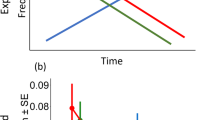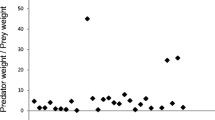Abstract
Animal feeding ecology and diet are influenced by the fear of predation. While the mechanistic bases for such changes are well understood, technical difficulties often prevent testing how these mechanisms interact to affect a mesopredator’s diet in natural environments. Here, we compared the insectivorous lizard Acanthodactylus beershebensis’ feeding ecology and diet between high- and low-risk environments, using focal observations, intensive trapping effort and fecal pellet analysis. To create spatial variation in predation risk, we planted “artificial trees” in a scrubland habitat that lacks natural perches, allowing avian predators to hunt for lizards in patches that were previously unavailable to them. Lizards in elevated-risk environments became less mobile but did not change their microhabitat use or temporal activity. These lizards changed their diet, consuming smaller prey and less plant material. We suggest that diet shifts were mainly because lizards from risky environments consumed prey items that required shorter handling time.



Similar content being viewed by others
References
Abramsky Z, Strauss E, Subach A, Kotler BP, Riechman A (1996) The effect of barn owls (Tyto alba) on the activity and microhabitat selection of Gerbillus allenbyi and G. pyramidum. Oecologia 105:313–319
Abramsky Z, Rosenzweig ML, Subach A (2002) The costs of apprehensive foraging. Ecology 83:1330–1340
Andersson J, Johansson F, Soderlund T (2006) Interactions between predator and diet induced phenotypic changes in body shape of crucian carp. Proc R Soc Lond B 273:431–437
Bouskila A (1995) Interactions between predation risk and competition: a field study of kangaroo rats and snakes. Ecology 76:165–178
Brown JS (1988) Patch use as an indicator of habitat preference, predation risk, and competition. Behav Ecol Sociobiol 22:37–47
Brown JS, Kotler BP (2004) Hazardous duty pay and the foraging cost of predation. Ecol Lett 7:999–1014
Christianson D, Creel S (2008) Risk effects in elk: sex-specific response in grazing and browsing due to predation risk from wolves. Behav Ecol 19:1258–1266
Cyr H, Peters RH, Downing JA (1997) Population density and community size structure: comparison of aquatic and terrestrial systems. Oikos 80:139–149
Diaz JA, Carrascal LM (1990) Prey size and food selection of Psammodromus algirus (Lacertidae) in central Spain. J Herpetol 24:342–347
Diaz JA, Carrascal LM (1993) Variation in the effect of profitability on prey size selection by the lacertid lizard Psammodromus algirus. Oecologia 94:23–29
Dill LM, Fraser AHG (1984) Risk of predation and the feeding behavior of juvenile coho salmon (Oncorhynchus kisutch). Behav Ecol Sociobiol 16:65–71
Fleishman LJ (1986) Motion detection in the presence and absence of background motion in an Anolis lizard. J Comp Physiol A 159:711–720
Griffiths D (1980) Foraging costs and relative prey size. Am Nat 116:743–752
Hawlena D, Bouskila A (2006) Land management practices for combating desertification cause species replacement of desert lizards. J Appl Ecol 43:701–709
Hawlena D, Boochnik R, Abramsky Z, Bouskila A (2006) Blue tail and striped body: why do lizards change their infant costume when growing up? Behav Ecol 17:889–896
Held J, Manser T (2005) A PDA-based system for online recording and analysis of concurrent events in complex behavioral processes. Behav Res Meth Ins C 37:155–164
Hodar JA (2006) Diet composition and prey choice of the southern grey shrike Lanius meridionalis L. in south-eastern Spain: the importance of vertebrates in the diet. Ardeola 53:237–249
Houston D, Shine R (1993) Sexual dimorphism and niche divergence—feeding habits of the Arafura filesnake. J Anim Ecol 62:737–748
Houtman R, Dill LM (1998) The influence of predation risk on diet selectivity: a theoretical analysis. Evol Ecol 12:251–262
Huey RB, Pianka ER (1981) Ecological consequences of foraging mode. Ecology 62:991–999
Kotler BP, Brown JS, Dall SRX, Gresser S, Ganey D, Bouskila A (2002) Foraging games between gerbils and their predators: temporal dynamics of resource depletion and apprehension in gerbils. Evol Ecol Res 4:495–518
Levins R (1968) Evolution in changing environments some theoretical explorations. Princeton University Press, Princeton
Lima SL (1985) Maximizing feeding efficiency and minimizing time exposed to predators—a trade-off in the black-capped chickadee. Oecologia 66:60–67
Lima SL (1998) Nonlethal effects in the ecology of predator-prey interactions: what are the ecological effects of anti-predator decision making? Bioscience 48:25–34
Lima SL, Bednekoff PA (1999) Back to the basics of antipredatory vigilance: can nonvigilant animals detest attack? Anim Behav 58:537–543
Lima SL, Dill LM (1990) Behavioral decisions made under the risk of predation—a review and prospectus. Can J Zool 68:619–640
Lima SL, Valone TJ (1986) Influence of predation risk on diet selections—a simple example in the gray squirrel. Anim Behav 34:536–544
Lima SL, Valone TJ, Caraco T (1985) Foraging-efficiency predation-risk trade-off in the grey squirrel. Anim Behav 33:155–165
Magurran AE (1988) Ecological diversity and its measurement. Princeton University Press, Princeton
Martín J, Avery RA (1997) Tail loss affects prey capture ‘decisions’ in the lizard Psammodromus algirus. J Herpetol 31:292–295
Martín J, Salvador A (1993) Tail loss and foraging tactics of the Iberian rock-lizard, Lacerta monticola. Oikos 66:318–324
Moravec J, Baha-El Din S, Seligmann H, Sivan N, Werner 501 YL (1999) Systematics and distribution of the Acanthodactylus pardalis group (Reptilia: Sauria: Lacertidae) in Egypt and Israel. Zool Mid East 17:21–50
Olesen JM, Valido A (2003) Lizards as pollinators and seed dispersers: an island phenomenon. Trends Ecol Evol 18:177–181
Pérez-Mellado V (1992) Ecology of lacertid lizards in a desert area of eastern Morocco. J Zool 226:369–386
Pérez-Mellado V, Corti C (1993) Dietary adaptations and herbivory in Lacertid lizards of the genus Podarcis from western Mediterranean islands (Reptilia: Sauria). Bonn Zool Beitr 44:193–220
Perry G (2007) Movement patterns in lizards: measurement, modality, and behavioral correlates. In: Reilly M, McBrayer LD, Miles DB (eds) Lizard ecology: the evolutionary consequences of foraging mode. Cambridge University Press, Cambridge, pp 13–48
Pincheira-Donoso D (2008) Testing the accuracy of fecal-based analyses in studies of trophic ecology in lizards. Copeia 2008:322–325
Preisser EL, Bolnick DI, Benard MF (2005) Scared to death? The effects of intimidation and consumption in predator-prey interactions. Ecology 86:501–509
Pyke GH, Pulliam HR, Charnov EL (1977) Optimal foraging—selective review of theory and tests. Q Rev Biol 52:137–154
Rothley KD, Schmitz OJ, Cohon JL (1997) Foraging to balance conflicting demands: novel insights from grasshoppers under predation risk. Behav Ecol 8:551–559
Schmitz OJ (1998) Direct and indirect effects of predation and predation risk in old-field interaction webs. Am Nat 151:327–342
Schmitz OJ (2008) Effects of predator hunting mode on grassland ecosystem function. Science 319:952–954
Schmitz OJ, Beckerman AP, Obrien KM (1997) Behaviorally mediated trophic cascades: effects of predation risk on food web interactions. Ecology 78:1388–1399
Schoener TW (1971) Theory of feeding strategies. Annu Rev Ecol Syst 2:369–404
Sheffield LM, Crait JR, Edge WD, Wang GM (2001) Response of American kestrels and gray-tailed voles to vegetation height and supplemental perches. Can J Zool 79:380–385
Skutelsky O (1996) Predation risk and state-dependent foraging in scorpions: effects of moonlight on foraging in the scorpion Buthus occitanus. Anim Behav 52:49–57
Sokal RR, Rohlf FJ (1995) Biometry, 3rd edn. Freeman, New York
Stephens DW, Krebs JR (1986) Foraging theory. Princeton University Press, Princeton
Suarez AV, Richmond JQ, Case TJ (2000) Prey selection in horned lizards following the invasion of Argentine ants in southern California. Ecol Appl 10:711–725
Vitt LJ, Pianka ER (2007) Feeding ecology in the natural world. In: Reilly M, McBrayer LD, Miles DB (eds) Lizard ecology: the evolutionary consequences of foraging mode. Cambridge University Press, Cambridge, pp 141–172
Ward D, Pinshow B (1995) Temperature regulation of the great grey shrike (Lanius excubitor) in the Negev desert. 2. Field measurement of standard operative temperatures and behavior. J Thermal Biol 20:271–279
Yosef R (1993) Influence of observation posts on territory size of northern shrikes. Wilson Bull 105:180–183
Acknowledgements
We thank Z. Abramsky and A. Bouskila who contributed substantially to the development of this research and J. Richardson, H. Jones, O. Schmitz, and three anonymous reviewers for helpful comments. We are indebted to all field assistants and to Z. Ortega for laboratory assistance. This research was supported by an International Arid Land Consortium grant (99R-10) to A. Bouskila, by the Gaylord Donnelley Environmental Fellowship to D. H. and by the CGL2006-10893-CO2-02 grant to V. P. M. The study was carried out with the appropriate permits from the Israeli Nature and Parks Authority.
Author information
Authors and Affiliations
Corresponding author
Additional information
Communicated by Raoul Van Damme.
Rights and permissions
About this article
Cite this article
Hawlena, D., Pérez-Mellado, V. Change your diet or die: predator-induced shifts in insectivorous lizard feeding ecology. Oecologia 161, 411–419 (2009). https://doi.org/10.1007/s00442-009-1375-0
Received:
Accepted:
Published:
Issue Date:
DOI: https://doi.org/10.1007/s00442-009-1375-0




